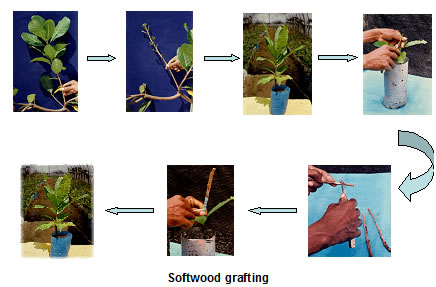VRI 1, VRI 2, VRI 3, VRI 4, VRI (CW) H1, vengurla 4, Vengurla 7 and BPP – 8 (H2/16) are the popular varieties.
1) Soil and Climate
It grows up well in all soils. Red sandy loam is best suited. Plains as well as hill slopes upto 600 - 700 feet elevation are suitable.
2)Season
June – December is optimum for cultivation.
3)Propagation
Mainly propagated by soft wood grafting, air layering and epicotyl grafting
 4)Requirement of plants
4)Requirement of plants
About 200 plants/ha can be planted.
5)Preparation of field
Pits of 45 cm x 45 cm x 45 cm size are dug and filled up with a mixture of soil + 10 kg FYM + one kg neem cake and 100 g Lindane 1.3 %.
6)Spacing
A spacing of 7 m either way is adopted.
7)High Density Planting
Spacing of 5 x 4 m accommodating 500 plants per hectare is recommended prune the interlocking branches during the July-August to maintain the frame.
8)Manuring (per tree)
| Manures and fertilizers |
I year old |
II year old |
III year old |
IV year old |
V year onwards |
| FYM or compost (kg) |
10 |
20 |
20 |
30 |
50 |
| N (g) |
70 |
140 |
210 |
280 |
500 |
| P (g) |
40 |
80 |
120 |
160 |
200 |
| K (g) |
60 |
120 |
180 |
240 |
300 |
Fertilizer application may be done during November - December in the East Coast areas. Wherever possible the fertilizer can be applied in 2 equal split doses during June-July and October-November periods under east coast area, a fertilizer schedule of 1000:125:250 g NPK/tree is recommended tree.
9)Intercropping
Plough the interspaces after the receipt of rain and raise either groundnut or pulses or minor millets till the trees reach bearing age.
10)Irrigation:
Normally grown as a rainfed crop. Irrigation once in a west from flinching to fruit maturity stage is good to increase the yield.
Develop the trunk to a height of 1 m by removing low lying branches. The dried twigs and branches should be removed every year.
Rejuvenation of old cashew orchard by top working
Old and senile cashew orchards with poor yielder are cut down leaving a stump of 1 – 3 m height from the ground level. The emerging new sprouts are used as rootstock for epicotyl grafting. Suitable scions are collected and grafted on to the new sprouts.